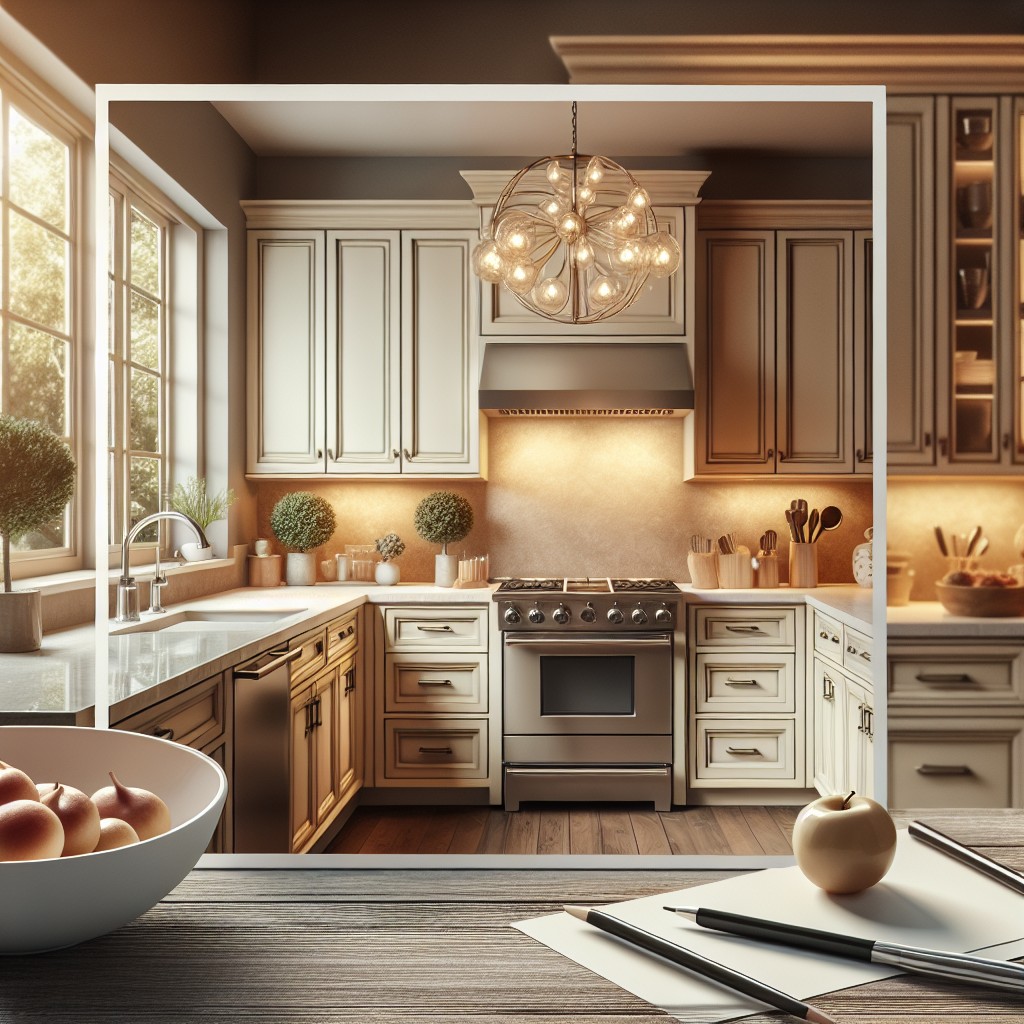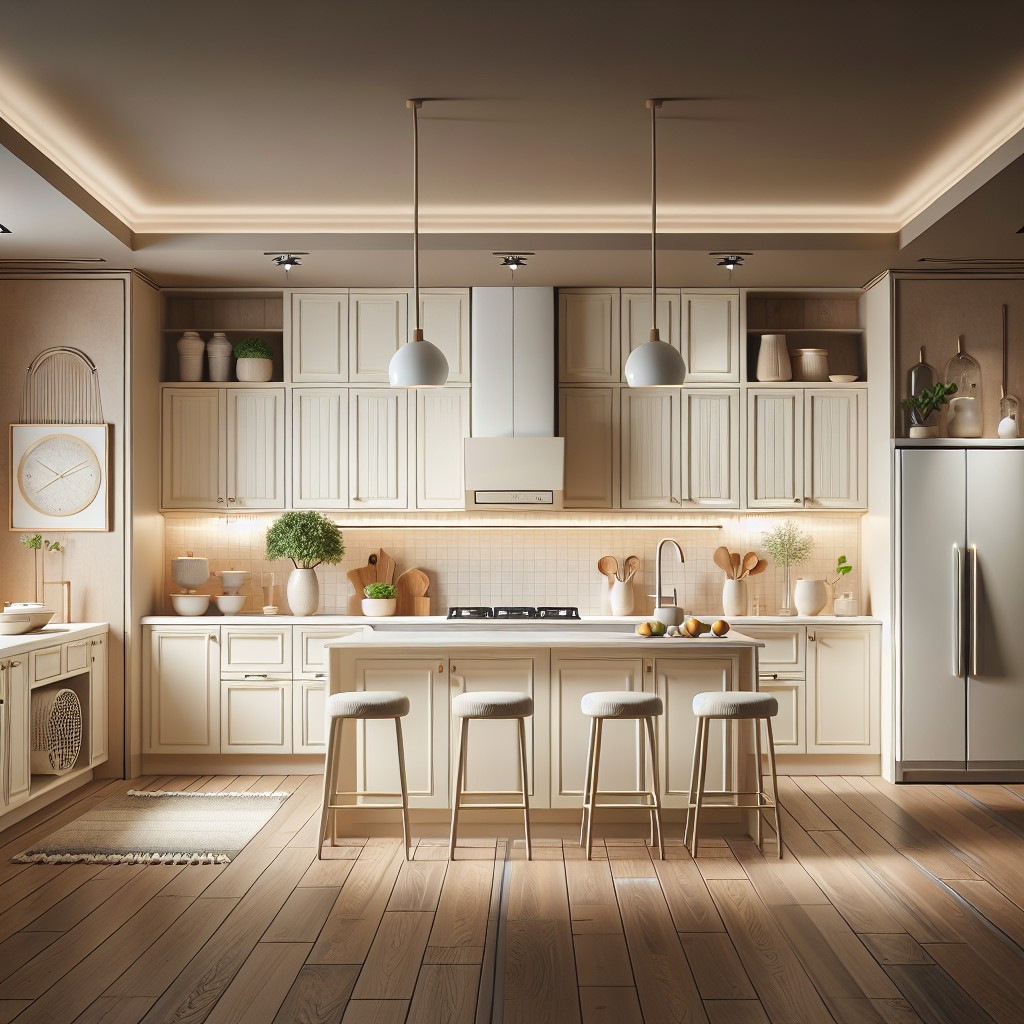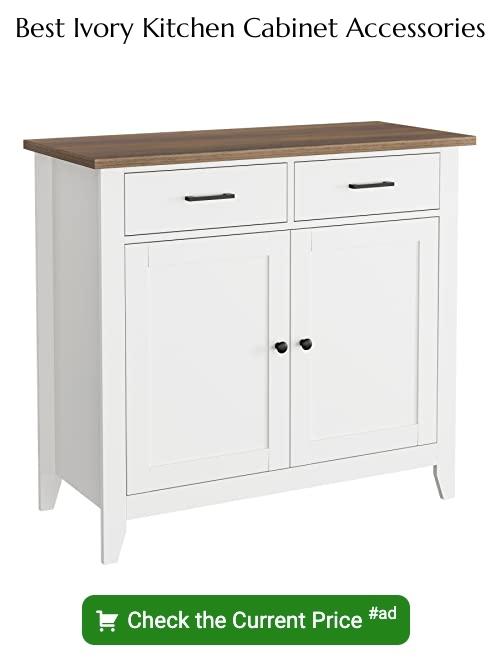Last updated on
Dive into this comprehensive guide exploring the best wall colors for your ivory kitchen cabinets because the perfect shade can enhance your space’s elegance, making your kitchen the heart of your home.
Key takeaways:
- Harmony Through Hues: Consider analogous colors for a seamless look.
- Contrast for Drama: Use colors directly opposite on the color wheel for a striking effect.
- Saturation and Balance: Balance the intensity of colors for a cohesive look.
- Emotional Impact: Choose a color that reflects the desired mood.
- Consistency in Design: Align the wall color with the overall design theme.
What's Inside
Understanding Color Theory and Ivory Cabinets

Diving into color theory offers helpful guidance when selecting the perfect wall hues to complement ivory cabinets. Ivory, a soft shade of off-white, contains warm undertones that can range from yellow to beige.
Harmony Through Hues: To ensure a harmonious kitchen environment, consider analogous colors—those next to each other on the color wheel. For ivory with yellow undertones, soft yellows or creams can create a seamless look.
Contrast for Drama: For a striking effect, colors directly opposite on the wheel, such as soft blues, provide a pleasing contrast without overwhelming the ivory’s subtlety.
Saturation and Balance: The saturation, or the intensity of color, should be balanced. Muted, pastel, or neutral walls maintain ivory’s delicate nature, while bold colors should be used sparingly to keep the ivory standout.
Emotional Impact: Color can influence mood. Cooler tones can create a calm atmosphere, while warmer ones offer coziness. Choose a color that reflects the mood you’re aiming for in your kitchen space.
Consistency in Design: The chosen wall color should align with the overall design theme of your home, whether it’s modern minimalism or rustic charm, to sustain design continuity.
Understanding these foundational principles helps in making informed decisions on wall colors that will best enhance the beauty and warmth of ivory kitchen cabinets.
Best Wall Colors for Modern Ivory Kitchen Cabinets

Pale Gray: For a chic and contemporary feel, opt for a pale gray. This cool tone creates a subtle contrast that allows ivory cabinets to stand out. It also works well with stainless steel appliances and modern hardware.
Soft Blue: A light, soft blue brings a serene and calming atmosphere to the kitchen. It pairs beautifully with ivory, evoking a sense of cleanliness and tranquility that’s perfect for a modern space.
Mint Green: Introduce a touch of nature with a muted mint green. This color is refreshing and pairs well with the warmth of ivory, offering a modern twist with an organic edge.
Earthy Taupe: A neutral, earthy taupe aligns with modern design principles, showcasing simplicity and sophistication. It provides a backdrop that enhances the creamy tones of ivory without overpowering the room.
Bright White: A bright, crisp white can amplify the light and space in a modern kitchen. It creates a seamless look with ivory cabinets, allowing you to play with textures and accent colors elsewhere in the room.
Charcoal: Make a bold statement with charcoal walls. The deep, rich color emphasizes the lighter tone of the ivory cabinets and injects a contemporary vibe into the kitchen.
Complementary Wall Colors for Traditional Ivory Kitchen Cabinets
Opting for soft pastels can enhance the classic charm of traditional ivory kitchen cabinets. Shades like pale blue, serene green, or even a gentle lavender can create a calming ambiance that complements the warmth of the ivory.
For those inclined toward earthy aesthetics, consider taupe or a muted terracotta, which ground the space with a subtle depth. Stark contrasts can be achieved with navy or a deep hunter green, offering an elegant backdrop that allows the ivory cabinets to stand out.
Stick to a matte or eggshell finish on walls to keep the look cohesive and refined. It’s important to sample your chosen hues in various lighting conditions within your kitchen to ensure they synchronize with the ivory cabinetry day and night.
Accent Wall Considerations With Ivory Cabinets
Opting for an accent wall is a savvy way to add depth and intrigue to a kitchen adorned with ivory cabinets. When selecting an accent color, aim for a shade that complements yet stands out against the ivory palette. Dark hues like navy blue or charcoal can create a striking contrast, bringing a touch of sophistication and drama to the space.
For a more subtle approach, consider earthy tones such as sage green or terracotta, which harmonize with ivory’s warmth and enhance a cozy, inviting atmosphere.
Reflect on the kitchen’s existing elements, like countertops and backsplashes, to ensure the accent wall ties the room together cohesively. Remember that the accent wall should serve as a focal point, so position it strategically — perhaps behind open shelving or along the wall where the range hood sits.
Ultimately, the accent wall should celebrate your personal style while coexisting harmoniously with the creamy tones of your ivory cabinets.
The Role of Lighting in Wall Color Choice
Lighting dramatically influences how your chosen wall color will appear in your kitchen throughout the day. Here’s how to ensure your wall hues align beautifully with ivory cabinets:
- Natural Light: Abundant sunlight can make colors appear brighter and more vibrant. If your kitchen receives plenty of natural light, consider cooler colors to balance the warmth of ivory.
- Artificial Light: The type of bulbs you use can affect color perception. Incandescent lighting brings out warm tones, while fluorescent lights highlight cooler shades, affecting how your wall color complements ivory cabinets.
- Directional Light: North-facing rooms might benefit from warmer wall colors to counteract the cool, indirect light. Conversely, south-facing rooms can often handle cooler wall colors.
- Reflections: Remember that colors from adjacent rooms can reflect and influence your kitchen’s wall color. Select a hue that remains harmonious with the overall palette of your home.
Always test paint samples in various lighting conditions before making your final decision to ensure consistency with your ivory cabinets regardless of the time of day or the type of lighting.
Tips for Choosing Wall Paint Finishes With Ivory Cabinets
Selecting the right paint finish can be just as impactful as the color itself, especially when it’s meant to complement the subtle elegance of ivory cabinets. When aiming for a sophisticated look, a satin finish offers a smooth touch and a slight gleam that’s both durable and easy to clean—ideal for kitchen walls.
For high-traffic areas or spaces prone to messes, such as near the stove or sink, consider a semi-gloss finish. Its higher resilience to moisture and cleaning products will keep walls looking fresh, despite the occasional spaghetti splash.
On the other hand, matte finishes absorb more light, providing a cozy ambiance that flatters the soft tones of ivory. This is best used in low-impact zones, away from the hustle of daily kitchen activity.
Bear in mind that surface imperfections are less forgiving with glossier finishes. If your walls have seen better days, a flat or matte finish can help hide those blemishes, making it a practical choice for older homes with plenty of character.
Experiment with samples on your walls before committing. The interplay of natural and artificial lighting in your kitchen can significantly alter the appearance of your chosen finish. By testing small sections, you’ll avoid future regrets and find the perfect complement to your ivory cabinets.
What Hardwood Floor Goes With Ivory Kitchen Cabinets
Selecting the right hardwood flooring to complement ivory kitchen cabinets can enrich the overall aesthetic of your space. Lighter woods such as maple or oak offer a subtle contrast that maintains a bright and airy feel. These woods also have the benefit of not showing dust as readily, ensuring a consistently clean look.
For those inclined towards a warmer palette, consider rich, dark woods like walnut or mahogany. These create a striking contrast that draws the eye, providing an anchor to the lightness of the ivory cabinets.
If you prefer a more uniform appearance, hardwood floors in a honey or caramel tone can achieve a seamless blend with the ivory, which is both inviting and harmonious.
Regardless of the shade chosen, ensuring the wood has a matte or satin finish can help minimize glare and reflections, which harmonizes with the gentle hue of ivory cabinetry. Remember, proper sealing and maintenance of the hardwood floors will protect their beauty for years to come, marrying durability with timeless design.
How to Paint a Kitchen With Ivory Cabinets
Kick-off your project by clearing out the kitchen or covering appliances, countertops, and floors with drop cloths to protect against splatters. Before you open a single paint can, remove any hardware from the cabinets to achieve a professional finish. It’s time to prep your surfaces; fill in any holes or nicks in the walls, sand them down, then clean the walls thoroughly to remove any grease or dust.
A primer is your friend, particularly if you’re making a drastic color change. It ensures better adhesion of paint to the surface, increases paint durability, and provides additional protection for the material being painted.
When choosing your paint, consider a semi-gloss or gloss finish for the walls; they’re easier to wipe down and will reflect light, complementing your ivory cabinets. For a seamless look, use painter’s tape along edges and around your cabinets. Apply paint using a high-quality brush or roller, starting at the edges and moving inward. Multiple thin coats are better than one thick coat, as they dry faster and create a more even finish.
Once the walls are completely dry, carefully remove the painter’s tape, reattach hardware, and admire the new backdrop to your ivory cabinets that’s been achieved with finesse.
Accessorizing Around Ivory Cabinets and Wall Colors
Accessorizing adds character to your kitchen, enhancing the aesthetics created by the ivory cabinets and chosen wall color. Here’s how to complete the look:
- Metallic Accents: Brushed nickel or brass hardware can add warmth or coolness, depending on your wall color selection.
- Natural Elements: Wood or bamboo cutting boards and bowls introduce an earthy feel that complements ivory tones beautifully.
- Colorful Decor: Choose small appliances or decorative items in bold colors to add pops of vibrancy without overwhelming the space.
- Textiles: Rugs, curtains, and towels can incorporate texture and contrasting colors to balance the ivory and wall color.
- Greenery: Plants bring life to the kitchen and can soften the lines between cabinetry and wall color, integrating the design.
- Artwork: Hanging art provides an opportunity to inject personality and theme; select pieces that speak to the color palette for a cohesive vibe.
- Lighting Fixtures: Pendant lights or chandeliers provide functional lighting while serving as statement pieces that harmonize with your color scheme.
By thoughtfully selecting accessories, you not only add functionality but also create a cohesive and inviting kitchen environment.
Maintaining an Updated Look With Ivory Cabinets
Ivory cabinets radiate a timeless appeal but staying current with design trends ensures your kitchen doesn’t look dated. Here’s how to keep your space fresh:
- Update Hardware: Swap out old knobs and pulls for more contemporary options like brushed nickel or matte black.
- Introduce Bold Accessories: Add lively kitchen textiles or a statement vase to inject personality without overwhelming the space.
- Consider Backsplash Updates: A new tile pattern or color can modernize the look without requiring a full renovation.
- Refresh Wall Colors Regularly: A new coat of paint in trendy tones can transform your kitchen’s vibe instantly.
- Mix in Modern Appliances: Sleeker, stainless steel or integrated appliances give the kitchen a high-end, contemporary feel.
- Play with Open Shelving: Displaying a curated selection of dishware or decorative items adds visual interest and depth to your kitchen.
By integrating these elements, you’ll maintain a kitchen that is both classic and on-trend.
FAQ
What wall color goes well with ivory cabinets?
Ivory cabinets pair well with a wide range of colors, including neutral hues like grey, cream, and black, or more vibrant options such as pinks, blues, or greens for a bold and bright aesthetic.
What color walls go best with cream cabinets?
Blue walls complement cream cabinets excellently, with a spectrum of hues fitting various room sizes and contemporary design aesthetics.
What color pulls ivory cabinets?
Matte gold, brass, or champagne gold cabinet hardware color can enhance the beauty of ivory cabinets, accentuating cool undertones like blue and purple.
What paint colour goes with ivory?
The ivory paint colour pairs well with a wide range of shades, most notably beige, gold, navy blue, and maroon, owing to its versatile neutral characteristics.
How to choose the perfect backsplash color for an ivory setting kitchen?
Choose the perfect backsplash color for an ivory setting kitchen by opting for earthy tones such as taupe, green, and brown, or using colors on the warmer end of the spectrum like peach or golden yellow, to create a harmonious and elegant ambiance.
What color floor complements ivory kitchen cabinets best?
Dark wood or natural stone colors complement ivory kitchen cabinets best.
How does lighting affect the color combination of ivory cabinets and specific wall colors?
Lighting can significantly influence the perception of how ivory cabinets interact with different wall colors, causing variations in warmth, depth, and overall ambiance.





